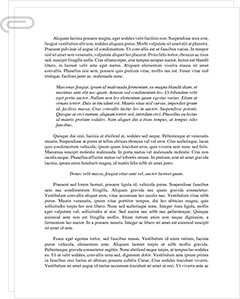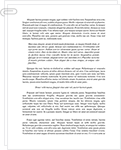 Study Document
Study Document
Pablo Escobar Research Paper
Pages:5 (1470 words)
Sources:6
Subject:Government
Topic:Pablo Escobar
Document Type:Research Paper
Document:#90013199
Pablo Escobar: A Classic Anti-Hero
Pablo Escobar established his reputation as a modern-day Robin Hood: a man who genuinely did come from a humble working class background and who at some point did actually give a lot of money away to social service organizations in Colombia. He was also an astute businessman who recognized trends and opportunities in the illicit drug trade. Yet Escobar was no hero; he was “violent” and “ruthless,” (“Pablo Escobar Crime Files,” 1) and was directly responsible for “terror campaigns that resulted in the murder of thousands,” (“Pablo Escobar Biography,” 1). This dichotomous figure has become one of the world’s most notorious anti-heroes. He became so iconic as to have his story been made into numerous television shows and films, such as the Netflix series Narcos. Escobar’s story reveals the inherent problem with the war on drugs, and signals the need for change in international drug policy.
Escobar was born on December 1, 1949 in Rionegro, Antioquia. His father was a manager of a farm, and his mother was a teacher at a rural school. While his family was not poor, they were certainly not rich either. However, Escobar’s father worked for a man named Joaquin Vallejo Arbaláez, who became Pablo’s godfather. Arbaláez had served as a United Nations delegate and was a “highly respected intellectual,” perhaps the first person to inspire Pablo towards positions of power and leadership (Thompson.55). In fact, Arbaláez has been credited with inspiring the teenage Escobar to become politically active, to serve in local community groups and in student organizations too (Thompson 55). Escobar continued to participate in political activity throughout his life, which is one of the reasons why he became known as more than just a drug lord but also as a politician.
Yet the young Escobar lacked access to wealth or public influence, which might have been why he initially turned to illicit activities in order to build himself a reputation and a bankroll. While in high school, he had a reputation for mischief. He started to steal tombstones, rubbing off the names to sell them to Panamanian smugglers (“Pablo Escobar Crime Files” 1). He also reportedly sold fake diplomas (“Pablo Escobar Biography” 1). Then, Escobar shifted to higher stakes crimes like car theft and dealing drugs. His start in the drug trade began with cannabis, and then he made a name for himself in cigarette smuggling during what has been since dubbed the “Marlboro Wars,” (“Pablo Escobar Biography” 1). Escobar played a “high profile role” as a cigarette smuggler, which “proved to be a valuable training ground for the future narcotics kingpin,” (“Pablo Escobar Biography” 1).
In the early 1970s, Colombia was a hub in the cannabis trade, but had yet to establish itself as ground zero for cocaine.…
…resort, going on killing sprees that resulted in a dramatic shift in how the public perceived him. Escobar went from being the Robin Hood of Medellin to being just another cartel leader. It is estimated that Escobar killed thousands of people (“Pablo Escobar Biography” 1). In 1991, he surrendered to the Colombian government in exchange for their agreement not to extradite him to the United States. Remarkably, the Colombian government agreed to allow Escobar to live sequestered in the lap of luxury, a “prison” he designed himself replete with “casino, spa, and nightclub,” (“Pablo Escobar Biography” 1). In June of 1992, Escobar managed to escape after he found out the authorities decided to move him to a standard prison. He was caught in Medellin in 1993, and died after a dramatic rooftop shootout with the police.
Escobar left a colorful and controversial legacy in Colombia. Oddly enough, his death did not result in the total dismantling of the cocaine trade and the data actually reveals the opposite. In the years following Escobar’s death, production of cocaine increased by a rate of 143% (Kenney 188). Moreover, Medellin has experienced a cultural revival since Escobar’s death and the downfall of his Medellin cartel. In fact, local tour companies offer Escobar-themed tours and peddlers sell Escobar-themed souvenirs to tourists who romanticize the drug lord (Pobutsky 684). Escobar’s legacy and the public’s ongoing fascination with organized crime perhaps…
Sample Source(s) Used
Works Cited
Kenney, Michael. “From Pablo to Osama: Counter-terrorism Lessons from the War on Drugs.” (2003). Survival, 45(3), 187–206. doi:10.1080/00396338.2003.9688585
“Pablo Escobar Biography.” Biography.com. Accessed 4 Dec, 2019 from https://www.biography.com/crime-figure/pablo-escobar
“Pablo Escobar Crime Files.” Crime and Investigation. Accessed 4 Dec, 2019 from https://www.crimeandinvestigation.co.uk/crime-files/pablo-escobar
Pobutsky, Aldona Bialowas. “Peddling Pablo: Escobar's Cultural Renaissance.” Hispania, Vol. 96, No. 4, Dec 2013, pp. 684-689.
Thompson, D. P. (1996). Pablo Escobar, Drug Baron: His surrender, imprisonment, and escape. Studies in Conflict & Terrorism, 19(1), 1996: 55–91. doi:10.1080/10576109608435996
Related Documents
 Study Document
Study Document
Pablo Escobar and the War
Escobar would help to demonstrate that there is a fundamental danger that the tactics of extremity which are part and parcel to the War on Drugs will only beget the tactics of extremity which Escobar and his ilk have perpetrated. The continued tolls of the conflict are highlighted by individual instances of brutality that are only partially motivated by economics. As a means to an end, Escobar also filled
 Study Document
Study Document
Drug King Pin, Pablo Escobar. The Writer
drug king pin, Pablo Escobar. The writer examines the life of Escobar and the role he played in the criminal justice system as well as how organized crime may be different had Pablo Escobar not existed. There were five sources used to complete this paper. The war on drugs is a worldwide effort. Drug pins and drug lords are constantly being sought out as the central factors of the drug
 Study Document
Study Document
Role That Bail Is Playing in the
role that bail is playing in the criminal justice system and how these amounts are determined. This is accomplished by looking at the Robert Blake murder trial, the Roman Polanski rape case and the Carlos Lehder drug trial. Once this occurs, is when we can understand how and why this applied differently in a host of court cases. One of the core elements of the criminal justice system is bail.
 Study Document
Study Document
Gangs This Is a Guideline
In the 1940s, the Klan began using bombings of their homes to scare blacks who had moved into the "wrong" neighborhood. In 1944, the IRS filed a lien against the Klan for over $600,000 and it was forced to disband. Its numbers by then had dwindled to about 10,000. During the 1950s, to the present day, the Klan has disintegrated into separate small groups with different purposes depending on location.
 Study Document
Study Document
Gabriel Garica Marquez Books Gabriel
This may be because of the fact that the author took it upon himself to reveal the names of the hostages who were killed and who were ultimately released. Since the main drama in the book is trying to imagine what will happen next, there is no fun in reading what has happened after knowing the ending of the book. (News of a Kidnapping) After reading the book, Villamizar
 Study Document
Study Document
Volkswagen Emissions Fraud
Decisions Influenced by Bias
Volkswagen produced vehicles that were equipped with emissions controls that were designed to shut off once the cars had passed regulatory tests. As s result, not only did the cars pollute more in real life than in those tests, but the company benefitted from these tests financially, because they showed that diesel engines were less polluting than gasoline ones. The result was misleading the public, making




